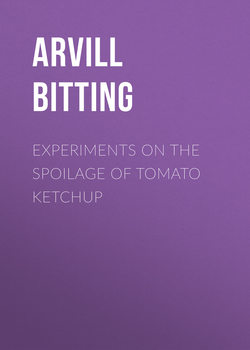Читать книгу Experiments on the Spoilage of Tomato Ketchup - Arvill Wayne Bitting - Страница 5
MANUFACTURING EXPERIMENTS WITHOUT THE USE OF PRESERVATIVES
ОглавлениеOUTLINE OF THE EXPERIMENTS
During September, 1907, ketchup was made in experimental batches to determine whether it could be manufactured on a commercial scale without the use of preservatives. These experiments were made to determine (1) the keeping quality before opening the container and (2) the length of time the product will keep without spoilage after the bottle is opened.
The ketchup was made in a factory in which the conditions of manufacture and all the surroundings were sanitary; whole, ripe tomatoes, the same as used in the regular grade of canned goods, were used and the formula and process were for a mild ketchup giving the maximum of tomato flavor. Each batch consisted of 50 gallons of finished goods, from which 1 gross of pint bottles was retained for observation.
The term “regular ketchup” as used in these experiments means the pulp of fully ripe tomatoes, to which was added granulated sugar, 80-grain, distilled vinegar, table salt, onions, garlic, whole cinnamon, cloves, mace, and ground cayenne pepper. The pulp was cooked in a steam-jacketed copper kettle for forty minutes and reduced about 50 per cent. The finishing was done after cooking. The regular bottles are pint sizes, washed in hot water, rinsed, and then heated to a temperature of 190° F. for thirty minutes or more. The sterile bottles referred to in the experiments were placed in a steam chamber for twenty minutes at 230° F. The corks were sterilized by a bath in paraffin at about 270° F. All of the work was accomplished quickly to insure a smooth, even product with a bright, clean color. Acetic acid extracts and oil extracts of spices were used in such quantities as would give the same amount of spicing as when the whole spices were employed.
